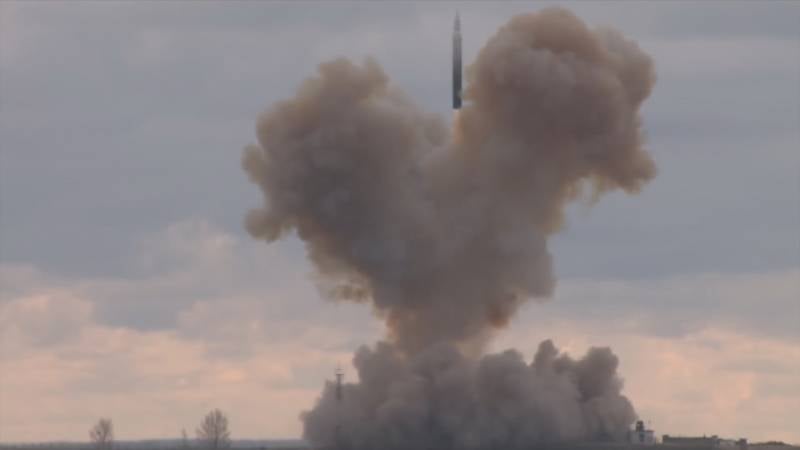Complex "Avangard". Benefits and Counteraction
Benefits and Threats
According to known data, the Avangard missile system includes several basic elements. The first is an intercontinental ballistic missile, which is responsible for accelerating and bringing the combat unit to the calculated trajectory. At the first stage in this role, the UR-100N UTTH missiles will be used, and in the future the complex will be built on the basis of the promising ICBM RS-28 Sarmat. The second element is a hypersonic planning combat unit. After acceleration and discharge from the rocket, he must fly to the target and destroy it with the help of the built-in warhead.
A planning winged warhead is more than seriously different from traditional warheads for ICBMs, both in terms of technology and in terms of operating principles. Unlike "normal" warheads, the winged product is capable of making a gliding flight, and not just "fall" on the target. In addition, the ICBM in the active area gives it a high speed. All this gives the block a number of characteristic advantages.
The first advantage of the Avant-garde combat unit is high speed. At the end of December, according to the results of the next test run, it was reported that the speed M = 27 was reached. At this speed, the combat unit is able to reach the target area in the shortest possible time, and thus drastically reduce the permissible response time of the enemy’s air and missile defense systems. Since the planning combat unit does not have its own power plant, its speed on the trajectory should gradually decrease due to the loss of energy to overcome the resistance of the environment. However, in this case, the speed of the product in the final part of the trajectory remains extremely high.
The second positive feature is the presence of control systems that provide for maneuvering during flight. Trajectory change can be used to reach the goal on the optimal route or as an anti-zenith maneuver. It has been repeatedly noted that maneuvering makes the trajectory of the warhead unpredictable for the enemy. As a consequence, Avangard becomes an extremely difficult target for intercepting existing missile defense systems designed to combat ballistic missiles.
Maneuvering also improves the accuracy of hitting the target. Traditional combat units are guided immediately after the end of the active part of the flight, after which their trajectory does not change. The Avant-garde combat unit is able to adjust its trajectory until the target is hit. This gives an obvious increase in combat effectiveness, regardless of the type of warhead used.
A planning combat unit can use its capabilities to fly both in the atmosphere and beyond. Due to this, it is possible to use higher trajectories that reduce energy consumption and increase the flight range. In addition, it is possible to fly in the atmosphere, making it difficult to detect using ground-based missile warning systems using modern warning systems. Also eliminates the effective work of the existing interceptor missile interceptor missiles.
Thus, the Avangard missile system most seriously differs from the existing ICBMs and has a number of major advantages over them. This is the possibility of flying to targets in an increased range of distances, increased accuracy of destruction, etc. For the means of defense of the likely adversary, the Avant-garde combat unit turns out to be an extremely difficult goal, combining the basic qualities of weapons of other classes. It is difficult to detect and accompany, and an effective attack with the help of modern missile defense or air defense systems is almost completely excluded.
This year, the missile troops of strategic purpose will receive the first production models of the Avangard complex. At first, only a few promising products will be put on duty, but in the future their number will constantly grow. The command does not specify its plans for the medium and long-term, but there is reason to believe that during this period the Avangard will become an important part of the weapons of the Strategic Missile Forces, and dozens of such systems will be on duty.
Given the high technical characteristics and unique combat potential, it is easy to imagine how the new Avangard products will affect the capabilities of the rocket forces and strategic nuclear forces in general. From the point of view of a potential enemy, the latest Russian missile systems look like a very serious threat.
Responding to threats
Obviously, the likely adversary understands all the risks associated with the latest Russian weapons, and is already looking for ways to respond to it. Creating new types of weapons and equipment that can withstand Avangard may take a lot of time, but the basic methods and ways to reduce the threat are already clear. Indeed, Avangard is not without flaws or ambiguous features that can be used against it.
First of all, it should be noted that the launch of the UR-100N UTTH or PC-28 missile with the Avangard on board will not go unnoticed. The likely enemy has satellite reconnaissance and a missile attack warning radar capable of tracking ICBM launches. This means that the enemy command will know in time about the launch, and he will have some time to react.
Depending on the chosen flight trajectory, the planning combat unit may be noticeable beyond the horizon of the enemy’s radar or be outside their range. In flight, the hypersonic Avangard should form around itself a cloud of plasma fixed by infrared reconnaissance satellites. If a spacecraft of this kind is capable of not only fixing warm-contrast targets, but also providing real-time target designation, the enemy’s chances of responding to the threat increase slightly.
Successful interception of a hypersonic airframe on the main part of the trajectory using existing air defense systems is simply impossible. The solution of such a task eliminates the combination of height, speed and maneuverability that is unprofitable for air defense.
Missile defense systems have greater potential, but even in their case, success is not guaranteed for a number of reasons. For example, the main US anti-missiles use a kinetic method of interception, which requires the highest precision targeting. The ballistic target moves along a predictable path, and it is relatively easy to direct a missile at it. The avant-garde bloc can literally dodge such an attack.
To increase the potential of anti-missile systems in the context of interception of hypersonic planning combat units, rather old but proven ideas can be used. Due to the high speed of the flight, any objects represent a danger to the Avangard block. A collision even with a small damaging element can lead to structural damage and destruction of the aircraft due to high loads of various kinds. Thus, it makes sense to carry out interception using a missile carrying a fragmentation warhead.
You can also recall more bold decisions. In the past, interceptor missiles with a neutron warhead were built and put into service. It was assumed that such a large-capacity ammunition would reduce the requirements for the accuracy of the anti-missile, but would provide it with high efficiency. The stream of fast neutrons, formed when the neutron charge is detonated, should hit the nuclear warhead of the target and provoke its destruction. Such equipment has already been used in missile defense complexes, but has long been decommissioned.
In theory, existing anti-missiles are still capable of intercepting hypersonic units. A small part of the final leg of the flight, which implies a fall on the target, the combat unit can pass along a ballistic trajectory. However, its speed should be significantly less than the maximum. In such conditions, serial interceptors designed to combat the ballistic targets of limited speed get some chances to cope with Avangard.
At the level of a curious, but not the most convenient and simple proposal, it is worth considering fundamentally new types of weapons. For example, a satellite with so-called could be a good means of interception. neutron gun or x-ray emitter. Such a product can be considered a good alternative to an anti-missile with a neutron warhead. Missiles with fragmentation charges can be replaced by a laser orbital-based system. She will have to damage the body of the combat unit, weakening it and causing further damage. All alternatives look interesting and promising, but such ideas are far from practical implementation and implementation in the armed forces.
Weapon and fight with him
From the available data, it follows that the Russian Strategic Missile Forces are armed with a unique strike complex with a number of critical capabilities. The missile complex with the Avangard hypersonic planning combat unit is capable of solving the same tasks as intercontinental ballistic missiles with conventional warheads, but has a number of advantages. The latter are directly related to overcoming the enemy’s missile defense.
Avangard is capable of attacking strategic targets faster, more accurately, and less likely to intercept than traditional ICBMs, but still not without flaws. So, according to some information, one rocket cannot carry several warheads, and the latter are difficult to manufacture and are distinguished by high cost. In addition, in projects of warheads for ICBMs, long-known and proven solutions are used, while the creation of the Avant-garde took a long research period.
Despite the advantages, the Avangard complex, at least at the level of theory, is not invulnerable. Its blocks cannot be considered fundamentally protected from interception, and one hundred percent breakthrough of missile defense is not guaranteed. Even at the level of the general concept, the hypersonic planning unit has specific features that can become weaknesses or help the enemy in intercepting.
However, modern and prospective air and missile defense systems cannot yet cope with the threat in the form of Avangard. They are able to fix the launch and even track the flight of the combat unit, but its interception is not guaranteed. You can try to intercept the ICBM with the planning unit in the active part of the trajectory or attack the "falling" airframe in the terminal part of the trajectory. However, the solution of such problems is also associated with a number of serious problems.
Modern air defense and missile defense systems that are in the arsenal of a potential adversary cannot cope with the threat in the form of Avangard. Nevertheless, there are ways of their development that can lead missile defense and air defense to the desired state and desired results. This requires the development of fundamentally new interceptor missiles and the creation of other defense algorithms. Obviously, this requires a lot of time and money. For this reason, for some time the likely adversary will remain defenseless.
The Avangard missile system, with all its advantages, cannot forever remain invulnerable. In the distant future, foreign countries may have new air and missile defense systems capable of coping with such a threat. Their development will become a separate problem, but the results of such projects will be of great importance. Russia should take into account such a scenario and improve the latest weapons. With the advent of the serial Avangard, our Strategic Missile Forces gain an advantage over foreign protection systems, and it must be preserved in the future.
On the materials of the sites:
http://mil.ru/
https://tass.ru/
https://ria.ru/
https://zvezdaweekly.ru/
https://militarywatchmagazine.com/
https://freebeacon.com/
http://rbase.new-factoria.ru/
https://fas.org/
- Ryabov Kirill
- RF Ministry of Defense / mil.ru



Information